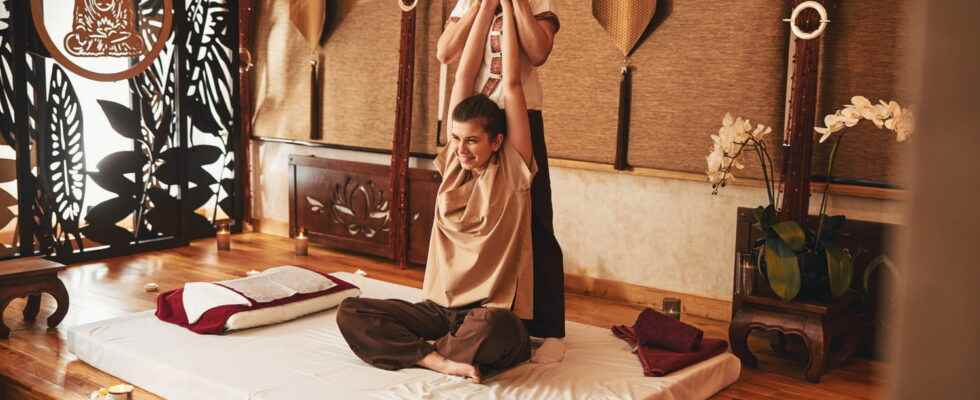At the crossroads of Buddhism, Ayurveda and traditional Chinese medicine, Thai massage aims to revive vital energy in the body. What are its origins ? What techniques were used ? What are the benefits and precautions to take?
Definition: what is a Thai massage?
Thai massage is inspired by ancient Ayurvedic and Chinese medicine practices. If its origins remain enigmatic, we know that it was born about 2500 years ago when doctors and Buddhist monks arrived in Thailand. the Wat Pho temple, located in Bangkok, is considered the birthplace of traditional Thai massage. Thai philosophy considers that life is driven by vital energy. This circulates in our body through nadis, made up of 72,000 energy channels. But when it is blocked or restricted, health problems can develop: Thai massage, by stimulating the points of circulation of prana, aims to remove blockages and treat the disorders suffered.
What is the Thai massage technique?
Thai massage is a complete massage, which solicits all parts of the body. The massage is practiced on the ground, on a tatami or mat, to give more amplitude to the practitioner. It usually starts with a manipulation of the soles of the feet, to get an overview of the strengths and weaknesses of the body. The therapist performs pressure movements on the lines and meridians, to restore the proper circulation of energies in the organism, prana. “He uses his palms, his thumbs, his arms and forearms, his elbows but also his knees and his feet to perform the manipulationsexplains Laurence Antonucci, psychocorporal therapist and trainer. The massaged person is also active during the session: a phase ofstretching follows the massage phase, to release tension and regenerate the body. These are not exercises strictly speaking, but movements intended to complete the work carried out on the lines of energy and the pressure points.“.
What are the benefits of Thai massage and when to do it?
Traditionally, Thai massage unifies body and mind and improves well-being. It can be used for preventive or therapeutic purposes. “At the physical level, Thai massage helps to relieve back pain, headaches, general fatigue and circulatory problems“, specifies our expert. It promotes flexibility and allows you to benefit from a better range of motion. The pressures, stretching and mobilizations practiced also induce a state of general well-being, relieve nervous tension, sleep disorders, overcomes stress and helps to let go.
Where to do a Thai massage?
Thai massage is given in massage centers and institutes. “It is also practiced by well-being practitioners trained in the method and installed in independent practices.says Laurence Antonucci. To find a center or a serious practitioner, rely on word of mouth, make sure that your practitioner’s training is serious, and do not hesitate to read the opinions and recommendations.“.
How long does a Thai massage last?
If, in Occident, a Thai massage lasts 1 hourin Thailand, a complete treatment can last between 2 and 3 hours on average.
What are the risks of Thai massage?
As the massage requires some stretching and joint mobilization type practices, it can be at risk for people suffering from joint weakness, herniated disc and osteoporosis.
What are the contraindications of a Thai massage?
It is contraindicated in case of phlebitisat the pregnant women, children and people with joint disorders (arthritis, polyarthritis). It is better to avoid having recourse to it in the event of cardiovascular diseases, skin lesions and bone fragility (recent fractures, dislocations, etc.). “Because of its action on the lymphatic circulation, massage is contraindicated in the case of serious illnesses, such as cancerr“, adds the therapist.
thanks to Laurence Antonuccipsychocorporal therapist and trainer.
